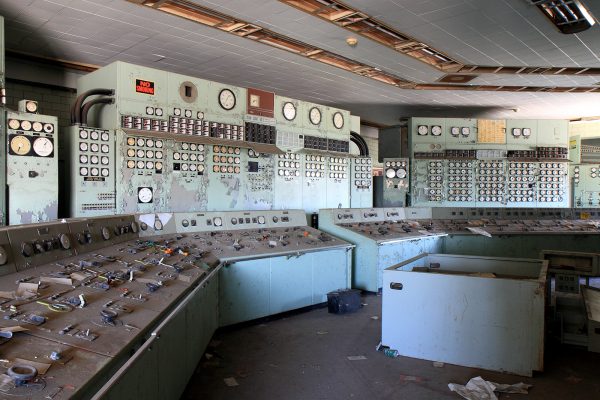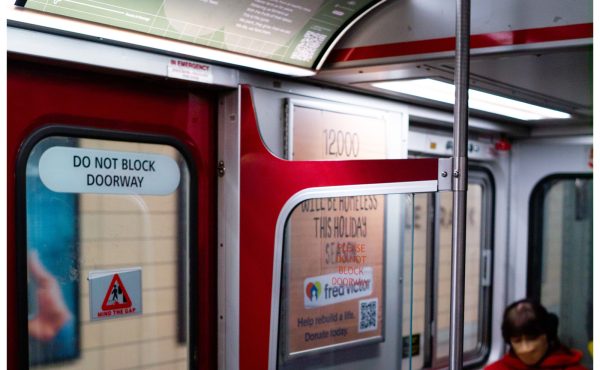This weekend, Jorn Weisbrodt, Luminato’s outgoing artistic director, watched the proverbial curtain rise on what will, in all likelihood, be his most audacious creation at the helm of a festival mandated to deliver audacity.
After a two year campaign, Weisbrodt is presiding over the awe-inspiring debut of the Hearn Generating Station’s new role as a, well, generator of culture, defined as broadly as his fertile imagination could push that over-used word.
The festival invested $2.5 million to transform the mammoth space into a fun-house resplendent in its deeply authentic sense of industrial ruin, and then packed it with high art, low art and every kind of art in between. There’s a disco ball hanging from a ferocious-looking crane hook, a French bistro in the station’s Three Mile Island-like control room, and a pharaonic concrete tunnel lined with glowing installations.
Until now, Herzog de Meuron’s Tate Modern, located famously in Sir Giles Gilbert Scott’s monumental Bankside Power Station in London’s Southwark borough, surely held the title of the world’s coolest mega-museum, and can be credibly described as the high altar of steam punk. But Weisbrodt’s ideology for the Hearn aspires to incinerate the Tate’s formula (modern art + tarted up industrial architecture) by smashing apart the silos between forms and then erasing the already blurry lines separating party palace and art venue.
As he all but snarled during his umpteenth media tour last week, the very act of comparing to the two spaces – that quintessentially Torontonian tic – bespeaks a facile type of civic immaturity. “It’s a sign of puberty,” Weisbrodt opined, quotably. “The Hearn doesn’t need to compare itself to other places in the world. To me,” he continued, “this is very much a place about the future. It’s not a retro kind of idea.”
It’s way too soon to say what will become of the Hearn after this year’s Luminato, although Weisbrodt stresses that he (and by implication the festival) wants it to evolve, somehow, into a more permanent version of what’s going to take place there until the end of June.
The contradictions built into Weisbrodt’s vision for the Hearn have their parallel, or reflection, in the derelict industrial wasteland that surrounds the plant.
The quality that is so entrancing about what Luminato has achieved with the Hearn this year is that it is so unapologetically provisional. Partisan’s design is the architectural equivalent of improvisation, preferably with home made instruments. Obviously, the festival has neither the funds nor the mandate to do a full-on reno (yet). But Weisbrodt clearly recognizes the transgressive appeal of doing art (and parties) amidst the epic wreckage of a gutted generating station. It’s fun for the same reason that Graffiti Alley is fun: no one’s come through with a broom. The Hearn is what it is, and by the way there’s cool art stuff in shipping containers all over the joint.
Yet the very act of making the Hearn a permanent facility will almost certainly undermine that delicious sense of being in a place you’re not supposed to be. Indeed, I’d argue that the crowds can’t help but force the normalization of the space, and then produce the sorts of requirements that will make the Hearn less like the immense skeleton that Weisbrodt fell in love with.
Similarly, we should also ask what a permanent or quasi-permanent Hearn does to the way we are thinking about the re-development of the Portlands.
In many ways, the tension between the gritty industrial heritage of the Portlands and the proposed redevelopment strategies for the waterfront are just a larger scale version of the dilemma facing the Hearn-as-permanent-culture-box.
It is not at all difficult to imagine a domesticated version of a Hearn precinct: a tidied up Unwin Ave., with sidewalks, bike share stalls, cafes, retail, and maybe a boutique hotel, as well as the obligatory run of restaurants with patios overlooking the turning basin. Here is a park, there is a cluster of mid-rise condos and townhouses, some commercial space over yonder, and so on.
Point is, the relationship between the current industrial uses and the potential culture maven/tourist/resident uses is inherently unstable. To see the Hearn in its derelict, retro splendour is to immediately appreciate its aesthetic. But when we aggregate up that interest across thousands or tens of thousands of visitors, it necessarily obliterates the authenticity and atmosphere that drew us (via the vector of Weisbrodt’s fertile imagination) there in the first instance.
The precedents are legion: 48 Abell, and the 19th and early 20th century industrial buildings that once stood in Liberty Village, Queen West, etc. New York’s High Line is another case in point: the grass roots vision for an abandoned elevated rail spur become a place, which then became a global phenomena, which begat the real estate speculation that rapidly transformed Manhattan’s meat packing district into a post-industrial playground for the super-rich and the ultra-hip.
While Waterfront Toronto, which has a general mandate to oversee the eventual redevelopment of these lands, regularly talks about the importance of protecting aspects of the industrial character of the Portlands, the challenges become very obvious and specific when we ponder the impact of an anchor tenant – sorry, but it is – like a re-fashioned Hearn.
What seems clear to me is that the solution for both the Hearn’s inside and its surroundings is the mindful recognition of the importance of not-planning as a planning tool. The crowds will make demands, and the market, in turn, will gradually reveal to the planners and the landowners and ultimately the developers what is possible commercially. Money can be made. Yet if Waterfront Toronto is genuinely thinking about the sustainability of the Portland’s industrial heritage, as vividly embodied by the Hearn, the agency must come to terms with the self-negating nature of the re-colonization and taming of such spaces.
I don’t think a city’s neglected industrial zones are necessarily eradicated through redevelopment. There are examples (Rotterdam, Copenhagen, even London’s Docklands) where new and old have figured out how to co-exist. But unless that potential dynamic is specifically acknowledged up front, erasure seems almost inevitable.



